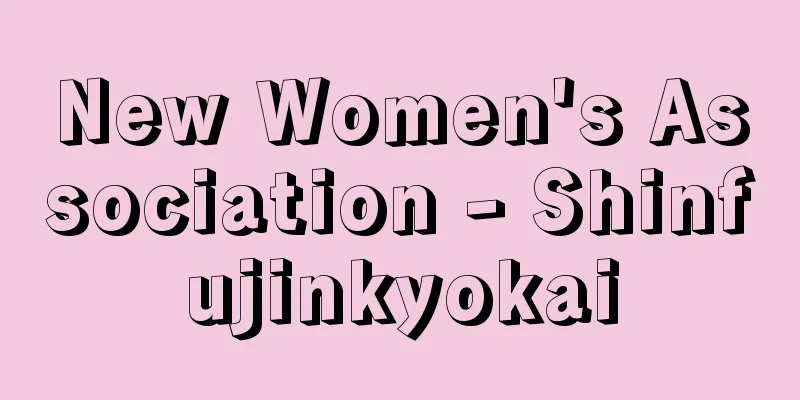New Women's Association - Shinfujinkyokai

|
A civil women's group founded on March 28, 1920 (Taisho 9) by Hiratsuka Raicho with the aim of improving women's social and political status. Hiratsuka, Ichikawa Fusae, and Oku Mumeo became directors, and petitioned for amendment of Article 5 of the Public Order Police Law (prohibiting women from political activities), women's suffrage, and marriage restrictions for venereal men. 70 people (including about 20 men) attended the opening ceremony, including Shimanaka Yusaku, editor-in-chief of Fujin Koron, and socialist Sakai Toshihiko, and expectations were high from all quarters. The platform included "equal opportunities for men and women," "recognition of gender differences based on the equal value of men and women," "clarification of the social significance of the family," and "protection of the rights of women, mothers, and children," which reflected Raicho's belief in respecting motherhood. By September 1920, the number of members, including female teachers and female journalists, had reached 331, and in October of the same year, the association launched its journal, the Women's Alliance. In March 1922, it succeeded in amending Article 5, Section 2 of the Public Order and Police Law to only allow women to participate in political speeches, but at this time, disagreements arose within the association. Yamakawa Kikue of the Sekirankai also criticized these movements as having bourgeois limitations. Although the association was dissolved in December 1922, it played a major role in the history of the women's suffrage movement in Japan. [Yoneda Sayoko] Source: Shogakukan Encyclopedia Nipponica About Encyclopedia Nipponica Information | Legend |
|
平塚らいてうの呼びかけにより、婦人の社会的・政治的地位の向上を目ざして1920年(大正9)3月28日に発会した市民的婦人団体。平塚、市川房枝(ふさえ)、奥むめおが理事となり、治安警察法第5条(女子の政治活動禁止条項)の修正、婦人参政権要求、花柳病男子の結婚制限に関する請願活動を行った。発会式には70名(うち男子約20名)が集まったが、『婦人公論』編集長の嶋中雄作(しまなかゆうさく)や社会主義者の堺利彦(さかいとしひこ)も出席、多方面から期待が寄せられた。綱領として「男女の機会均等」「男女の価値同等観」の上に立った男女の差の承認、「家庭の社会的意義を闡明(せんめい)」すること、「婦人、母、子供の権利を擁護」することなどが掲げられたが、これには母性尊重を唱えるらいてうの思想が反映している。会員は女教師、婦人記者などを含めて1920年9月に331名を数え、同年10月には機関誌『女性同盟』を創刊した。22年3月には、女子の政談演説会参加のみを認める治安警察法第5条2項修正に成功したが、この時期、協会内部には意見の不一致が生じていた。また赤瀾会(せきらんかい)の山川菊栄(きくえ)は、それらの運動をブルジョア的な限界をもつものと批判した。22年12月解散に至るが、日本の婦人参政権運動史上大きな役割を果たした。 [米田佐代子] 出典 小学館 日本大百科全書(ニッポニカ)日本大百科全書(ニッポニカ)について 情報 | 凡例 |
Recommend
Alalia chinensis (English spelling) Alaliachinensis
…[Nitta Aya]. . . *Some of the terminology that m...
Awashima Gannin - Awashima Gannin
...One theory is that Awashima-sama was the wife ...
Ferris wheel
〘 noun 〙 A device that hangs many boxes for specta...
Akitsuso
…The city was also a key transportation point whe...
Leicester (sheep) (English spelling) Leicester
…The most common varieties are Lincoln (native to...
Lycia; Lykia
Ancient name of a region in southwestern Anatolia ...
husaria
…Batoly made Zamoyski his deputy in 1876 and vizi...
Albu Masaru - Albu Masaru
… As Augustine wrote in The City of God, astrolog...
Babak Rebellion - Babak no Ran
A rebellion (816-837) led by Bābak (?-838), a lead...
Fire-extinguishing festival - Chinkasai
Also known as the "Hishizume Festival". ...
Horse ranch - Umamaki
...However, it is true that Nukabe has been famou...
Decriminalization
Decriminalizing acts that were previously consider...
Offside - Offside (English spelling)
Offside fouls in soccer that are related to the of...
Hylocomium brevirostre (English spelling) Hylocomiumbrevirostre
… [Kitagawa Takashi]. … *Some of the terminology ...
Criminal Record - Zenka
Having been convicted and sentenced to a crime. T...









